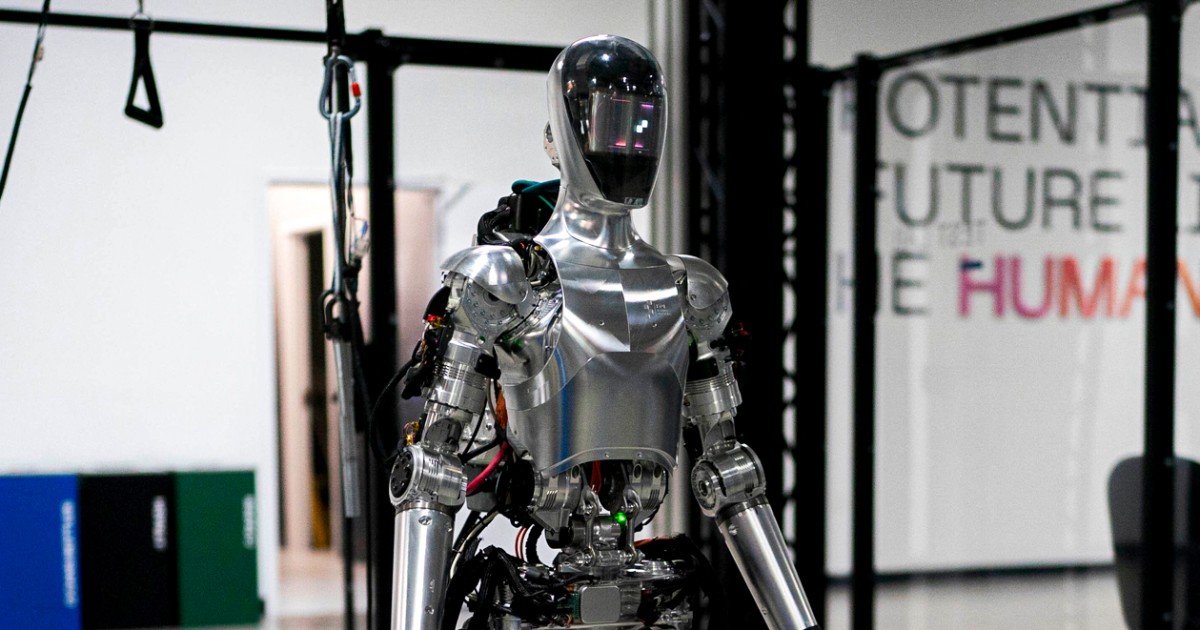UPS Exploring Humanoid Robots With Figure AI

Table of Contents
The Potential of Humanoid Robots in Warehousing and Logistics
Traditional warehouse automation, relying heavily on conveyor belts and automated guided vehicles (AGVs), often struggles with the variability inherent in handling diverse packages. Humanoid robots, however, offer a far more versatile solution. Their dexterity and adaptability allow them to tackle a wider range of tasks, leading to increased efficiency and a significant reduction in operational bottlenecks.
Humanoid robots can perform a variety of crucial warehouse functions, including:
- Picking: Selecting individual items from shelves with precision.
- Packing: Carefully placing items into boxes and securing them for shipment.
- Sorting: Categorizing and organizing packages for efficient routing.
- Moving packages: Transporting packages between different warehouse zones.
The advantages of integrating humanoid robots are numerous:
- Increased efficiency and speed: Robots can work tirelessly, completing tasks faster than humans in many cases.
- Improved accuracy in handling diverse packages: Their advanced sensors and AI allow for precise handling of various shapes and sizes.
- Reduced labor costs and human error: Automation reduces reliance on manual labor and minimizes errors associated with repetitive tasks.
- Greater flexibility in adapting to changing warehouse layouts: Humanoid robots can navigate dynamic environments with ease.
Figure AI's Technology: A Closer Look
Figure AI's technology is at the heart of this revolutionary partnership. Their humanoid robots are equipped with cutting-edge features designed specifically for demanding warehouse environments. This includes:
- Advanced dexterity: Enabling them to handle delicate or irregularly shaped items with precision.
- AI-powered navigation: Allowing them to move autonomously and efficiently through complex warehouse layouts.
- Object recognition: Enabling robots to identify and sort packages accurately.
Key technological aspects of Figure AI's robots include:
- Proprietary AI algorithms: Optimized for efficient task completion and continuous learning.
- Advanced sensor integration: Providing precise movements and reliable obstacle avoidance.
- Durable and adaptable design: Built to withstand the rigors of warehouse operations.
- Integration capabilities with existing warehouse management systems (WMS): Seamlessly integrating with existing infrastructure.
UPS's Strategic Investment in Automation
This collaboration with Figure AI aligns perfectly with UPS's broader strategy of embracing automation to enhance its operational efficiency and customer satisfaction. UPS recognizes the transformative potential of robotics in managing the ever-increasing volume of packages and maintaining its position as a global leader in logistics.
This partnership offers UPS numerous benefits:
- Competitive advantage in the rapidly evolving logistics sector: Staying ahead of the curve through technological innovation.
- Enhanced operational efficiency and cost savings: Optimizing warehouse operations and reducing labor costs.
- Improved employee safety through automation of strenuous tasks: Reducing the risk of workplace injuries associated with repetitive manual labor.
- Ability to handle increasing package volumes efficiently: Scaling operations to meet growing demands.
The Future of Human-Robot Collaboration in Logistics
The future of logistics isn't about robots replacing humans; it's about human-robot collaboration. Humanoid robots will handle repetitive and physically demanding tasks, freeing up human workers to focus on more complex and strategic roles. Addressing concerns about job displacement requires proactive investment in reskilling and upskilling programs to prepare the workforce for the changing landscape.
The future of this technology holds exciting possibilities:
- Increased autonomy and sophistication of humanoid robots: Leading to even greater efficiency and capability.
- Wider adoption across various sectors of the logistics industry: Expanding beyond warehousing to encompass last-mile delivery and other areas.
- Development of safer and more collaborative human-robot interaction: Ensuring a harmonious and productive work environment.
- Continued innovation and improvement in robotic technology: Pushing the boundaries of what's possible in automation.
Conclusion: The Transformative Power of UPS Exploring Humanoid Robots with Figure AI
The partnership between UPS and Figure AI represents a significant leap forward in logistics automation. By leveraging the power of humanoid robots, UPS is poised to enhance efficiency, reduce costs, and improve customer service. This collaboration signals a future where human ingenuity and robotic capabilities work hand-in-hand to revolutionize how we move goods, making the delivery process smoother, faster, and more reliable. Stay tuned for updates on how UPS and Figure AI are revolutionizing the future of logistics with humanoid robots! Learn more about the groundbreaking advancements in humanoid robotics by visiting the UPS and Figure AI websites.

Featured Posts
-
 V Mware Costs To Skyrocket At And T Reports 1050 Price Hike From Broadcom
May 01, 2025
V Mware Costs To Skyrocket At And T Reports 1050 Price Hike From Broadcom
May 01, 2025 -
 Win Big At Eurovision 2025 Comprehensive Betting Guide
May 01, 2025
Win Big At Eurovision 2025 Comprehensive Betting Guide
May 01, 2025 -
 New Southern Cruises For 2025 Top Picks And Itineraries
May 01, 2025
New Southern Cruises For 2025 Top Picks And Itineraries
May 01, 2025 -
 Michael Sheen Pays Off 1 Million Debt For 900 People
May 01, 2025
Michael Sheen Pays Off 1 Million Debt For 900 People
May 01, 2025 -
 Samoas Triumph Miss Samoa Wins Miss Pacific Islands 2025
May 01, 2025
Samoas Triumph Miss Samoa Wins Miss Pacific Islands 2025
May 01, 2025
